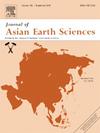Subsurface thermal properties in the deepwater South Makassar Basin, Indonesia
IF 2.7
3区 地球科学
Q2 GEOSCIENCES, MULTIDISCIPLINARY
引用次数: 0
Abstract
Sandwiched between southeastern Kalimantan and southwestern Sulawesi, the widespread presence of bottom simulating reflectors (BSRs) in the deepwater failed rift of the South Makassar Basin strongly indicates the extensive occurence of methane hydrates. Despite the region’s long petroleum exploration history, the understanding of thermal signatures in the basin remains enigmatic. This study utilized thirty-two legacy multi-channel seismic data surveys to derive heat flow, geothermal gradients, and thermal conductivity from BSRs. By assuming the depth range where methane hydrates remain stable, BSRs can act as a proxy for deducing information related to thermal properties when direct thermal measurements are scarce. Estimated thermal properties indicate a mean heat flow of 86 mW/m2, a mean geothermal gradient of 73 °C/km, and a mean thermal conductivity of 1.19 W/m.°C at water depth between 400 and 2050 m. These values differ from marine-probe references in the area, with heat flow and thermal conductivity being on average 34 % and 58 % higher, respectively, geothermal gradients being 13 % lower, and geothermal gradients averaging 30 % higher than exploration wells. The variance between the drilling depth at which methane hydrates were penetrated in three exploration wells and the theoretical base of methane hydrate stability zone vary between a deviation of 6–19 m. Discrepancies in thermal properties values and depth of methane hydrates are attributed to methodological disparities, uncertainties in theoretical assumptions, and geological factors such as thermal uplift from the mantle beneath the thinned lithosphere and localized fluid advection.
印度尼西亚南望加锡盆地深水的地下热特性
夹在加里曼丹东南部和苏拉威西西南部之间的南望加锡盆地深水失败裂谷中广泛存在的底部模拟反射器(BSRs)强烈表明甲烷水合物的广泛存在。尽管该地区的石油勘探历史悠久,但对盆地热特征的理解仍然是一个谜。该研究利用32个遗留的多通道地震数据调查,从bsr中获得热流、地热梯度和导热系数。通过假设甲烷水合物保持稳定的深度范围,当缺乏直接热测量时,bsr可以作为推断热性质相关信息的代理。估计的热性质表明,平均热流为86 mW/m2,平均地热梯度为73°C/km,平均导热系数为1.19 W/m。在水深400至2050米之间°C。这些值与该地区的海洋探测参考值不同,热流和导热系数平均分别高出34%和58%,地热梯度平均比探井低13%,地热梯度平均比探井高30%。3口探井的甲烷水合物钻探深度与甲烷水合物稳定带理论基础的偏差在6 ~ 19 m之间。甲烷水合物热物性值和深度的差异归因于方法上的差异、理论假设的不确定性以及地质因素,如薄岩石圈下地幔的热隆升和局部流体平流。
本文章由计算机程序翻译,如有差异,请以英文原文为准。
求助全文
约1分钟内获得全文
求助全文
来源期刊

Journal of Asian Earth Sciences
地学-地球科学综合
CiteScore
5.90
自引率
10.00%
发文量
324
审稿时长
71 days
期刊介绍:
Journal of Asian Earth Sciences has an open access mirror journal Journal of Asian Earth Sciences: X, sharing the same aims and scope, editorial team, submission system and rigorous peer review.
The Journal of Asian Earth Sciences is an international interdisciplinary journal devoted to all aspects of research related to the solid Earth Sciences of Asia. The Journal publishes high quality, peer-reviewed scientific papers on the regional geology, tectonics, geochemistry and geophysics of Asia. It will be devoted primarily to research papers but short communications relating to new developments of broad interest, reviews and book reviews will also be included. Papers must have international appeal and should present work of more than local significance.
The scope includes deep processes of the Asian continent and its adjacent oceans; seismology and earthquakes; orogeny, magmatism, metamorphism and volcanism; growth, deformation and destruction of the Asian crust; crust-mantle interaction; evolution of life (early life, biostratigraphy, biogeography and mass-extinction); fluids, fluxes and reservoirs of mineral and energy resources; surface processes (weathering, erosion, transport and deposition of sediments) and resulting geomorphology; and the response of the Earth to global climate change as viewed within the Asian continent and surrounding oceans.
 求助内容:
求助内容: 应助结果提醒方式:
应助结果提醒方式:


